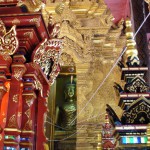
A day of many miles and wats, some ancient and some old.
The ancient ruins of Sukhothai National National Park are deservedly a World Heritage Site for here are the visible remains of one of the ancient capitals of the northern kingdom of Thailand dating from the 1300s.
On our visit today we concentrated on the district of Si Satchanalai, a large city about a kilometer by a kilometer and a half, with temples and burial grounds surrounded by city walls, many of which still stand. As in medieval Europe, the common people lived and farmed outside the walls, but fled to the city for protection from the many attacks by other kingdoms including Burma.
Most of the buildings were constructed of laterite, a brick-like material made out of fired clay; it’s astonishing that tourists can still walk all over this stuff. Good mud for rice apparently makes good mud for bricks too.
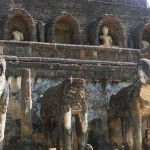
One temple we visited sat high atop dozens of laterite stairs on a hill, a serene and moody place of prayer and ruins, echoing with a multitude of nesting storks. In the valley, a much larger Wat sported many of the 39 elephant statues that originally surrounded its base. Nearby were many well preserved ruins from an imposing complex of temples and chedis tightly fitted into its own walled area. Much has fallen and worn away over time, but they still speak – as do Mayan and Roman ruins – of empires lost.

From here we drove north past banana and coconut plantations, plus endless fields of rice, all harvested by hand as we saw along the way. It was a bit like driving the farming roadways all over the U.S. In fact, we continue to be impressed by the quality of the roads, after our experiences in pot-holed Costa Rica. Signage along the way also gave us a chance to start recognizing Thai language characters. We can now identify the M character, the Ng and the Ah character; if we had 30 weeks in Thailand, we’d be dangerous!
At Lampang further north, the Wat Phra That Lampang Luang sat atop the only hill around and was filled with people visiting the area for the festival in nearby Chiang Mai and at the temple for prayer and devotion. We joined in the spirit of the place, by signing a cloth to be wrapped around the top of the huge chedi.
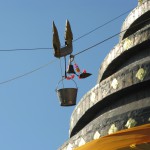
Then we donated for a cup of ceremonial water, which we drew by pulley up to the top of the chedi and spilled on its dome for luck. Why? Water is the essence of life and rain on the roof is good. The festival after all celebrates water and the city’s river (while asking for forgiveness for abusing it).
On the way into Chiang Mai, we stopped at a local market, one that most tourists troop to for the deals on chintzy local goods and unusual foods. We sampled the very spicy sausages coiled like snakes on display, and we tried some crickets (the guide was right, tasted like chicken),
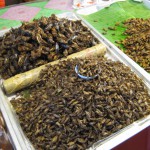
but not the large water beetles or the neatly trussed up grasshoppers.
Later, in town, we went to dinner under what seemed like a sky full of golden stars. They were really tissue-paper lanterns that people all over town had lit up and had lofted like hot air balloons into the sky. While eating, we watched the nightly festival procession from our table. Musicians and floats moved alongside the many people carrying flower arrangements called krathongs to place in the Ping River for good fortune and the water goddess.
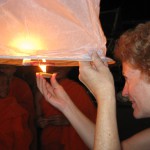 We seem to stumble upon festivals in our travels, not really seek them out. But we try to get in the spirit. On our way home we bought one of the lantern balloons. A kindly monk showed us how to work it. One uses a candle to light the round base of the contraption that is actually made of wax or sterno. That burns and heats up the air inside the paper lantern, and soon up it goes. We then helped others do the same thing and send theirs up to join the thousands of lanterns already in the sky. All in all a very fun time.
We seem to stumble upon festivals in our travels, not really seek them out. But we try to get in the spirit. On our way home we bought one of the lantern balloons. A kindly monk showed us how to work it. One uses a candle to light the round base of the contraption that is actually made of wax or sterno. That burns and heats up the air inside the paper lantern, and soon up it goes. We then helped others do the same thing and send theirs up to join the thousands of lanterns already in the sky. All in all a very fun time.
Our second day highlight was the 1600 meter high Wat Phra That Doi Suthep just above town. We reached the temple itself by climbing 310 steps up the hillside from the drop-off point, so it would be much closer to heaven, as the belief goes. This is the northern kingdom’s holiest shrine because it contains a relic – a piece of bone – from the Buddha. So here too many of the locals and those in town for the festival performed their religious rituals and paid devotion.
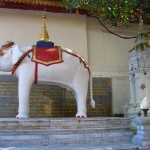
The legend of this place is that a white elephant was sent off from town carrying the Buddha relic. That animal wandered up the hillside, circled at the top three times, and then died at the spot where the king built the Wat for the relic. A statue of the elephant stands next to a white chedi containing its ashes. Not surprisingly, tusks decorate several of the many, many shrines here. So a white elephant is a good thing, for the white symbolizes perfection. So may all your elephants be white.
(For more pictures in a slide show, go to our Thailand itinerary page.)


You missed out… large water-beetles are delicious! …at least that’s what a monkey told me 😉
Erik got kicked out of the house and survives on water beetles under the BQE